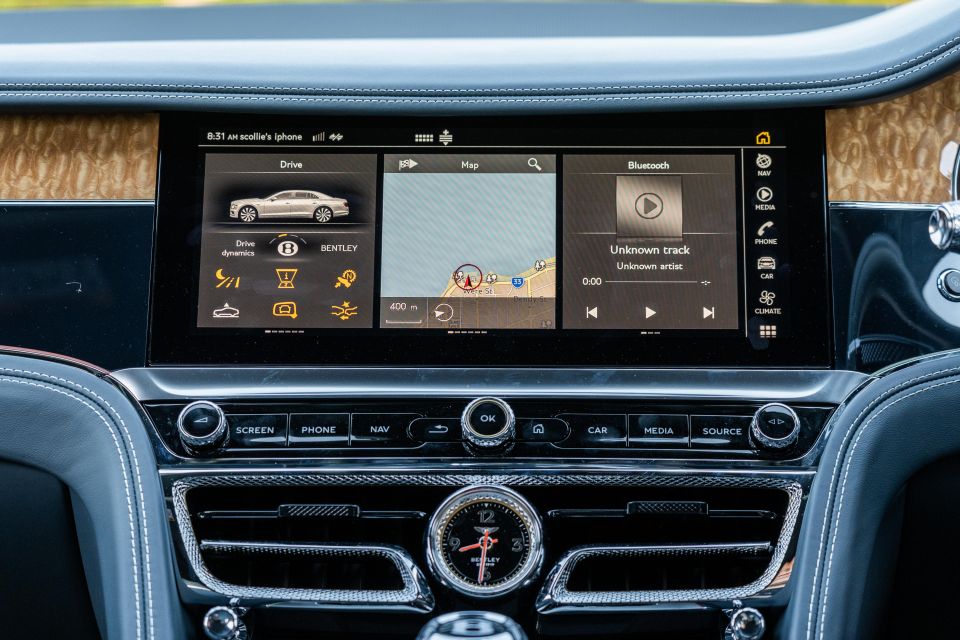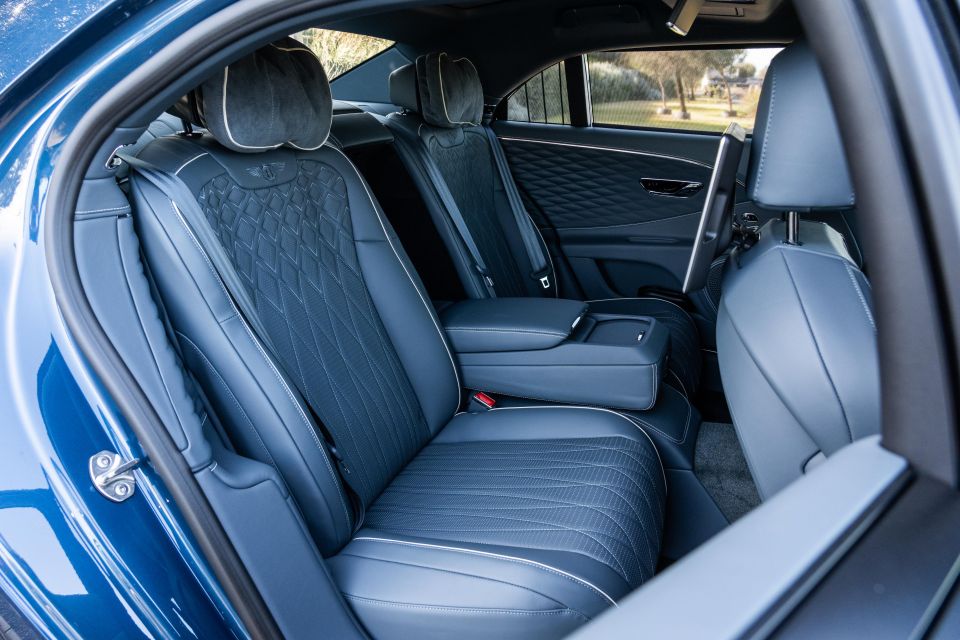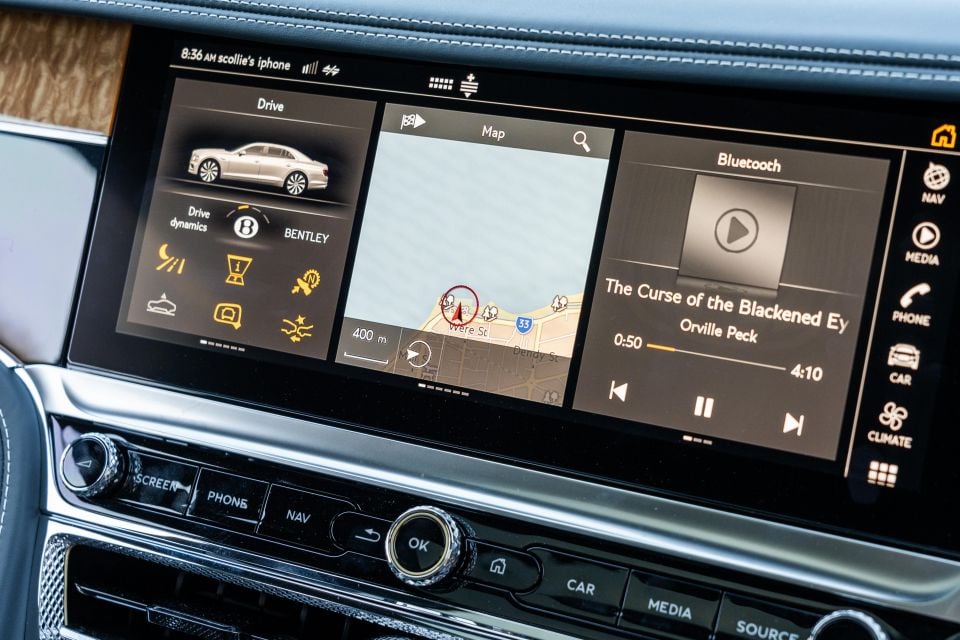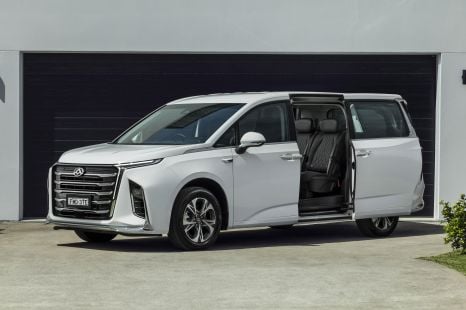

Matt Robinson
2026 Peugeot 308 Hybrid review: Quick drive
3 Hours Ago
Bentley is gearing up to go electric, and step one in the process is plug-in hybrids. The first to hit Australia is the Flying Spur.



Quickly see how this car stacks up against its competition. Select any benchmark to see more details.
Where expert car reviews meet expert car buying – CarExpert gives you trusted advice, personalised service and real savings on your next new car.
Bentley is going fully electric by 2030, but it’s not going to make the leap straight away. First, it’s going plug-in hybrid.

The first Bentley to feature plug-in hybrid power Down Under is the very large, very luxurious Flying Spur sedan. Yes, W12 and V8 engines are still available if you’re not quite ready to dip into the world of electrification yet.
It’s a brave new world for a brand built on the back of supercharged toys for wealthy playboys racing trains in the 1920s, which sold cars powered by a version of the same 6.75-litre V8 for more than six decades, and has more recently evolved into the final refuge for the Volkswagen Group’s technically fascinating (but vanishingly rare) W12 engine.
Making the transition to electrification more fascinating is the fact Bentley is starting with the Flying Spur, which is arguably its most old-fashioned vehicle. Its classical silhouette, and a leather-lined cabin aimed as much at pleasing people in the back seats as the front.
Have the engineers in Crewe managed to successfully blend the best of the old world with a thoroughly modern PHEV powertrain?
List price is just a concept with cars like the Flying Spur, given the whole point is to customise it and make it your own.

Regardless, the starting price of the Flying Spur is $456,000 before on-road costs. Our tester was optioned to $585,429 before on-roads.
How? Outside, the stunning Marlin paint is from the ‘Extended Range’ of finishes, and the Driving Specification with Black Painted and Bright Machined Wheel doesn’t come free. The bright chromed lower bumper matrix-style grille is also an option, along with the delightfully showy illuminated Flying B bonnet emblem.
Inside, the contrast stitching and seat piping, panoramic sunroof, rear entertainment system, decorative ‘Cotes de Geneve’ transmission tunnel insert, two-tone dashboard trim, diamond knurling, inductive phone charger, and mood lighting are optional.
You could spend hours on the Bentley configurator making the Flying Spur look how you like; turns out my dream specification isn’t far from what we drove.
Buy your new car without the stress. It's fast, simple and completely free.

Great service from Travis and team, second time I have used this business would not hesitate to recommend them to anyone
Craig C.
Purchased a Ford Ranger in Sunshine Coast, QLD
CarExpert helped Craig save thousands on his Ford Ranger, now let us save you on your next new car.
Find a dealThe feeling of the leather, the look of the walnut dashboard trim, and the cold knurled ‘organ stop’ vent stoppers are all standout Bentley touch points, but it’s the smell of the Flying Spur that stands out most. It just smells expensive.

Everything you touch feels high quality. The supple leather trim doesn’t just cover the seats, it covers the doors, and the pillars, and the sides of the transmission tunnel. It even extends over the sun visors, and the damped grab handles above the windows.
The brushed metal finisher on the transmission tunnel is cold to the touch, and the knurled buttons, dials, and organ stop vent adjusters haven’t been lifted from the Volkswagen Group parts bin. The only plastic we could find was on the steering wheel; even the indicators are finished with a metal effect cap to match the wider cabin.
Gloss black is one of our pet peeves, but the two-tone trim that combines black with your choice of wood is also a modern take on a classic element of interior design.


Don’t get me started on the knurled, metal-trimmed paddle shifters. So often they’re the touchpoint that undermines the feeling of quality in a high-end cabin, but not here.
As you’d expect, the driving position is perfect. The powered seats feature massaging, heating, and cooling, and have the right blend of bolstering and support to make long drives melt away. The view over the bonnet, complete with its central chrome strip that slopes down to meet the top of the (retractable) Flying B emblem, is unlike anything else in motoring.
The most noticeable link between the Flying Spur and the Porsche Panamera with which it shares a platform is the infotainment system, which is essentially a reskinned take on the PCM system offered across the Porsche range.


It’s easy enough to customise, and responds quickly to inputs. The fact you can have your major functions (including the raise suspension button) alongside your navigation, and your media, is a win. Also a win is the fact the climate controls are physical buttons on the transmission tunnel, and you don’t need to go swiping through menus to close the rear blinds, or activate the parking cameras when it’s time to thread this bulky beast into a narrow carpark.
The only real nods to the Flying Spur’s electrified drivetrain are the EV Mode button, and the revised digital dials in front of the driver. Speaking of which, although the graphics on the digital cockpit are a nice nod to the past, we’d love for Bentley to stick with jewel-like analogue dials to match the clock on the dashboard.
Arguably more lavish than the front seats are the rear pews. Although it features a three-seat bench, the huge driveline hump and scalloped outboard seats make the middle seat one for emergencies only.

Those outboard seats are power adjustable, massaging, and heated. There’s acres of legroom, but headroom back there is hurt by the panoramic sunroof on our tester. If you’re planning to carry fully-grown passengers regularly we’d recommend skipping the powered roof to free up more space.
Passengers are able to stream entertainment from a phone or tablet to the screens, so there’s no excuse for sub-par in-flight entertainment. We can’t speak for the Bentley meal service, of course.
Although the stunning two-tone dashboard and door finishers from the front haven’t made it down back, the rear seats are every bit as well finished as the fronts. The doors feature the same soft trim and diamond pattern as the front, and all the materials feel properly expensive.

Boot space has suffered in the transition from petrol-only to PHEV power. The Flying Spur Hybrid packs 351 litres of boot space, down on the 420L on offer in the V8 and W12.
Although this isn’t designed to be a school run car, you’ll notice it’s harder to fit bulky items back there because of the lithium-ion battery under the floor. Don’t worry, the golf clubs still fit – we tested it, naturally.
Under the skin, the Flying Spur rides on a version of the MSB platform underpinning the Porsche Panamera.

Its plug-in hybrid powertrain blends a 2.9-litre twin-turbocharged petrol V6 engine with an electric motor, for combined system outputs of 400kW and 750Nm.
The e-motor is capable of punching out 100kW and 400Nm; the petrol engine makes 305kW and 500Nm.
Those numbers don’t combine to create the quoted combined maximum as the electric motor and petrol engine don’t make their peak outputs at the same time.
The e-motor is mounted between the engine and the eight-speed dual-clutch transmission, and is mated to an 18kWh lithium-ion battery pack good for a claimed 40km of electric-only driving. A 7.2kW charger can juice the battery from empty in less than three hours.

Claimed fuel economy is 3.3 litres per 100km on the combined cycle, but that’s contingent on having a full battery. We saw 7.8 litres per 100km over a 130km loop.
The battery was fully charged at the start, and lasted just shy of 50km before running dry.
The Flying Spur will hit 140km/h on electric power alone, and flat out with both power sources singing will do 285km/h.
The 100km/h sprint takes a claimed 4.3 seconds, making the PHEV just 0.2 seconds slower than the V8, and 0.5 seconds slower than the W12.
Effortless performance and sporty, but dignified, handling is at the core of what Bentley has tried to do with its modern cars.

The Flying Spur mostly delivers on those promises, although the way the PHEV shuffles between its two power sources means it’s not quite as seamless as it might be with an old-fashioned petrol engine under the bonnet.
At low speeds, with a full battery, it does a pretty convincing impersonation of an electric vehicle. The 140km/h ceiling is enough that you never need the petrol engine on Australian highways, and with 400Nm of torque from the e-motor alone the big, heavy Flying Spur doesn’t feel slow when the turbocharged V6 is napping.
Smoothness and silence are no longer the preserve of luxury cars, given the strengths of electric motors, but the Flying Spur feels serene even relative to less expensive, luxurious electric cars.
Once the heavy, leather-lined door shuts (with an imperious thud) it’s as if the outside world doesn’t exist, such is the refinement. Also staggeringly good is the ride quality.

This is a 2500kg sedan riding on 22-inch alloy wheels, but in the default Bentley Mode the adaptive suspension just steamrolls pockmarked city streets. Potholes, expansion joints, speed bumps… none of them upset its composure, or undermine the sense of refinement in the cabin.
Three-chamber air springs combine with a continuously-adaptive damping system, which features four ride height sensors to constantly adjust the suspension stiffness in response to road conditions. Those air springs can hold up to 60 per cent more air than before.
This is a massive car. It’s barely shorter than, and is actually 70mm wider than, a Ford Ranger Wildtrak, so it’s not what you’d call easy to place in tight spaces.

The high-resolution cameras make it simpler, but piloting a Flying Spur in town isn’t for the faint of heart or light of wallet. Then again, owners know what they’re getting in for. If you want a small Bentley, buy a Continental.
Given its electric range is about 40km, you’ll need to fire the petrol engine at some point in the Flying Spur. At low speeds it fires quietly and quickly, and the way it interacts with the electric motor is pretty damn smooth. Some PHEVs feel like they surge forward when the engine kicks in, but the performance in the Flying Spur feels nice and linear.
It’s also surprisingly fast. In Bentley Mode, there’s a beat of hesitation when you bury the throttle before both power sources give you their all, but in Sport Mode the throttle response is pleasingly immediate. Roll on from low in the rev range and it just surges forward with a similar effortless, smooth feeling you get from the W12 in the Continental GT.
You don’t get the same dignified, bassy exhaust note on offer in the W12. The 2.9-litre twin-turbocharged V6 engine doing service in the Flying Spur PHEV features elsewhere in the Volkswagen Group performance world, but it always sounds a bit strained and reedy relative to the other engines in the range.

Where expert car reviews meet expert car buying – CarExpert gives you trusted advice, personalised service and real savings on your next new car.
The sound is fine, but you want more than fine from a Bentley, don’t you?
More than just fine is the handling. It’s impressive how hard you can hustle this hybrid limousine without it falling to pieces, given its size.
The steering has a reassuring amount of weight to it, and the body doesn’t lurch unnervingly around when you pour the Flying Spur into a corner at speed. It’s nicely controlled, and once settled you get the sense there’s plenty of grip when you feed in some throttle.
It’s not an outright athlete, but the big girl can still get up and boogie when she needs to.
Equipment fitted to our tester includes:




That’s atop the following standard features:
Don’t expect to see the Flying Spur crash tested any time soon. Cars with steep prices and low volumes rarely are.

Standard safety equipment includes:
The Bentley Flying Spur is backed by a three-year, unlimited-kilometre warranty.

Maintenance is required every 12 months or 16,000km, and five years of maintenance is included with the price of purchase.
The Flying Spur Hybrid is a solid first step into the world of electrification for Bentley in Australia.

It builds on the strengths of the wider range with a sumptuous interior, impressive ride quality, peerless refinement, and better performance than you’d expect of such a big beast.
The hybrid system shows the polish you’d expect from a Volkswagen Group product, and has been tuned to deliver a Bentley-ish feeling when you’re cracking on. It feels exactly how you’d expect a Bentley plug-in hybrid to feel.
That’s not to say it’s perfect. The electric range is solid but not standout, and Bentley has work to do on making the smaller petrol engine in the PHEV feel special like the V8 and W12 options that have underpinned the brand’s modern era.
The road there won’t be perfectly smooth, but there’s still plenty to look forward to as Bentley bids internal-combustion farewell.

Click the images for the full gallery
Where expert car reviews meet expert car buying – CarExpert gives you trusted advice, personalised service and real savings on your next new car.
Scott Collie is an automotive journalist based in Melbourne, Australia. Scott studied journalism at RMIT University and, after a lifelong obsession with everything automotive, started covering the car industry shortly afterwards. He has a passion for travel, and is an avid Melbourne Demons supporter.


Matt Robinson
3 Hours Ago


CarExpert.com.au
12 Hours Ago


William Stopford
14 Hours Ago


Damion Smy
14 Hours Ago


James Wong
15 Hours Ago


William Stopford
16 Hours Ago